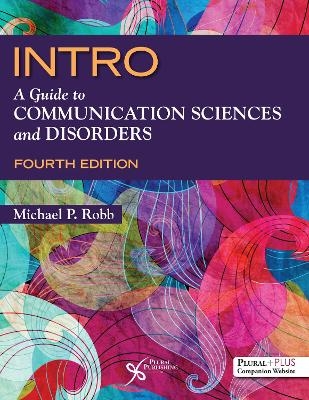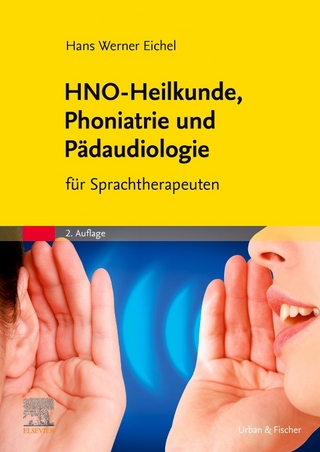
INTRO
Plural Publishing Inc (Verlag)
978-1-63550-476-7 (ISBN)
With its engaging color layout and easy to read writing style, INTRO: A Guide to Communication Sciences and Disorders, Fourth Edition is designed for undergraduate students with an interest in entering the field of communication sciences and disorders. INTRO is an introduction to the professions of speech-language pathology and audiology and the underlying discipline on which they are based, communication sciences and disorders. The text provides essential information concerning a wide range of communication disorders found in children and adults.
The structure of the book is consistent across chapters to assist beginning students in grasping new vocabulary and concepts. An introduction to each of the various disorders includes some of the fascinating historical background surrounding each disorder, as well as current theories. A portion of each chapter is dedicated to diverse and cultural aspects of communication disorders, as well as prevalent information about various communication disorders as found in English-speaking countries around the world, including Australia, Canada, the United Kingdom, the United States, and New Zealand.
New to the Fourth Edition
New chapters:
A new chapter on autism spectrum disorder
The original chapter covering neurogenic communication disorders has
been divided into separate chapters on neurogenic language disorders
and motor speech disorders
Updated history section for each chapter profiling the diverse contributions from individuals to the field of communication sciences and disorders
Updated the Cultural Considerations for each chapter
Updated online ancillary resources, and new eFlashcards for students
Key Features
Solo-authorship ensures a cohesive writing style throughout the book
A strong international focus
Each chapter begins with learning objectives and ends with study questions to review key concepts
Bolded key terms and a comprehensive glossary improve retention of the material
The text includes real-life examples in the form of video links to help reinforce the information in the text
Each chapter provides a focus on "past and present"
FYI boxes call out interesting and novel information
Full color design and images to engage undergraduate students
PluralPlus Online Ancillary Materials
For instructors: PowerPoint Slides, Test Bank, Sample Course Syllabus
For students: Practice Quizzes, eFlashcards, and Additional Web Resources
The text is also an essential text for speech-language pathology assistant (SLPA) courses.
Michael P. Robb, PhD, received his BS degree in speech pathology and audiology from Western Michigan University, and MS and PhD degrees in speech-language pathology from Syracuse University (New York). He has worked as a speech-language pathologist at the Meyer Children's Rehabilitation Institute in Omaha, Nebraska (now known as the Munroe-Meyer Institute for Genetics and Rehabilitation). Since obtaining his PhD, he has held faculty posts at the University of Hawaii, the University of Connecticut, the University of Canterbury in Christchurch, New Zealand, and most recently at the Pennsylvania State University. His specialty is experimental phonetics, with particular interest in aspects of speech motor control related to early speech acquisition, stuttering, and English as a Second Language. Professor Robb has been an active researcher since 1985. Over his career, he has presented more than 100 conference papers and published over 100 refereed journal articles. He holds the Certificate of Clinical Competency in speech-language pathology from the American Speech-Language-Hearing Association (ASHA) and was recognised as an ASHA Fellow in 2009. He is a member of the New Zealand Speech-Language Therapists Association (NZSTA) and served on the NZSTA Executive Board. He is the editor-in-chief of the Folia Phoniatrica et Logopaedica, which is the official publication of the International Association of Logopedics and Phoniatrics. Professor Robb has been recognized for his teaching excellence and has taught Intro throughout his career to students in the United States and New Zealand.
Foreword to the First Edition by John H. Saxman, PhD
Preface
Reviewers
Section 1. Background to Communication Sciences and Disorders
Chapter 1. Communication Disorders and the Professions
Objectives
Introduction
Terminology and Definitions
Models of Communication
The Professions
A Brief History of the Professions
Educational Preparation
Professional Work Settings
Professional Code of Ethics
Cultural Considerations and Communication Disorders
Summery of Chapter
The Professions of Audiology and Speech-Language Pathology on the World Wide Web
Study Questions
References
Appendix 1-A. ASHA Code of Ethics (2023)
Chapter 2. Anatomy of Speech and Hearing
Objectives
Introduction
Speech Anatomy
The Process of Speech Production
Hearing Anatomy
The Process of Hearing
Historic Aspects of Anatomy and Physiology
Cultural Considerations in Anatomy and Physiology
Summary of Chapter
Anatomy and Physiology on the World Wide Web
Study Questions
References
Section 2. Developmental Communication Disorders
Chapter 3. Child Language Disorders
Objectives
Introduction
Terminology and Definitions
Language Development
Historic Aspects of Child Language Disorders
Characteristics of Child Language Disorders
Current Theories Regarding Child Language Development and Disorders
Assessment of Child Language Disorders
Treatment of Child Language Disorders
Cultural Considerations and Child Language Disorders
Summary of Chapter
Child Language Disorders on the World Wide Web
Study Questions
References
Chapter 4. Child Speech Sound Disorders
Objectives
Introduction
Terminology and Definitions
Historic Aspects of Child Speech Sound Disorders
Characteristics of Speech Sound Disorders
Current Theories Regarding Child Speech Sound Disorders
Assessment of Child Speech Sound Disorders
Treatment of Child Speech Sound Disorders
Cultural Consideration and Child Speech Sound Disorders
Summary of Chapter
Child Speech Sound Disorders on the World Wide Web
Study Questions
References
Chapter 5. Fluency Disorders
Objectives
Introduction
Terminology and Definitions
Historic Aspects of Fluency Disorders
Characteristics of Fluency Disorders
Current Theories Regarding Stuttering
Assessment of Fluency Disorders
Treatment of Fluency Disorders
Cultural Considerations and Fluency Disorders
Summary of Chapter
Fluency Disorders on the World Wide Web
Study Questions
References
Chapter 6. Cleft Lip and Palate
Objectives
Introduction
Terminology and Definitions
Historic Aspects of Cleft Lip and Palate
Characteristics of Cleft Lip and Palate
Current Theories of Cleft Lip and Palate
Assessment of Cleft Lip and Palate
Treatment of Cleft Lip and Palate
Cultural Considerations and Cleft Lip and Palate
Summary of Chapter
Cleft Lip and Palate on the World Wide Web
Study Questions
References
Chapter 7. Autism Spectrum Disorder
Objectives
Introduction
Terminology and Definitions
Historic Aspects of Autism Spectrum Disorder
Characteristics of Autism Spectrum Disorder
Current Theories of Autism Spectrum Disorder
Assessment of Autism Spectrum Disorder
Treatment of Autism Spectrum Disorder
Cultural Considerations and Autism Spectrum Disorder
Summary of Chapter
Autism Spectrum Disorder on the World Wide Web
Study Questions
References
Section 3. Acquired and Genetic Communication Disorders
Chapter 8. Voice Disorders
Objectives
Introduction
Terminology and Definitions
Historic Aspects of Voice Disorders
Characteristics of Voice Disorders
Current Theories of Voice Disorders
Assessment of Voice Disorders
Treatment of Voice Disorders
Cultural Considerations and Voice Disorders
Summary of Chapter
Voice Disorders on the World Wide Web
Study Questions
References
Chapter 9. Neurogenic Language Disorders
Objectives
Introduction
Terminology and Definitions
Historic Aspects of Neurogenic Language Disorders
Characteristics of Neurogenic Language Disorders
Current Theories Regarding Neurogenic Language Disorders
Assessment of Neurogenic Language Disorders
Treatment of Neurogenic Language Disorders
Cultural Considerations and Neurogenic Language Disorders
Summary of Chapter
Neurogenic Language Disorders on the World Wide Web
Study Questions
References
Chapter 10. Motor Speech Disorders
Objectives
Introduction
Terminology and Definitions
Historic Aspects of Motor Speech Disorders
Characteristics of Motor Speech Disorders
Current Theories Regarding Motor Speech Disorders
Assessment of Motor Speech Disorders
Treatment of Motor Speech Disorders
Cultural Considerations and Motor Speech Disorders
Summary of Chapter
Motor Speech Disorders on the World Wide Web
Study Questions
References
Chapter 11. Dysphagia
Objectives
Introduction
Terminology and Definitions
Historic Aspects of Dysphagia
Characteristics of Dysphagia
Causes of Dysphagia
Assessment of Dysphagia
Treatment of Dysphagia
Cultural Considerations and Dysphagia
Summary of Chapter
Dysphagia on the World Wide Web
Study Questions
References
Chapter 12. Augmentative and Alternative Communication
Objectives
Introduction
Terminology and Definitions
Historic Aspects of AAC
Characteristics of AAC
Assessment of AAC
Treatment of AAC
Cultural Considerations and AAC
Summary of Chapter
AAC on the World Wide Web
Study Questions
References
Chapter 13. Genetics and Syndromes
Objectives
Introduction
Terminology and Definitions
Historic Aspects of Genetics
Characteristics of Syndromes
Assessment of Genetic Conditions
Treatment of Genetic Conditions
Cultural Considerations and Genetics
Summary of Chapter
Genetics and Syndromes on the World Wide Web
Study Questions
References
Section 4. Audition
Chapter 14. Hearing Disorders
Objectives
Introduction
Terminology and Definitions
Historic Aspects of Hearing Disorders
Characteristics of Hearing Disorders
Assessment of Hearing Disorders
Cultural Considerations and Hearing Disorders
Summary of Chapter
Hearing Disorders on the World Wide Web
Study Questions
Summary of Chapter
Cleft Lip and Palate on the World Wide Web
Study Questions
References
Chapter 7. Autism Spectrum Disorder
Objectives
Introduction
Terminology and Definitions
Historic Aspects of Autism Spectrum Disorder
Characteristics of Autism Spectrum Disorder
Current Theories of Autism Spectrum Disorder
Assessment of Autism Spectrum Disorder
Treatment of Autism Spectrum Disorder
Cultural Considerations and Autism Spectrum Disorder
Summary of Chapter
Autism Spectrum Disorder on the World Wide Web
Study Questions
References
Section 3. Acquired and Genetic Communication Disorders
Chapter 8. Voice Disorders
Objectives
Introduction
Terminology and Definitions
Historic Aspects of Voice Disorders
Characteristics of Voice Disorders
Current Theories of Voice Disorders
Assessment of Voice Disorders
Treatment of Voice Disorders
Cultural Considerations and Voice Disorders
Summary of Chapter
Voice Disorders on the World Wide Web
Study Questions
References
Chapter 9. Neurogenic Language Disorders
Objectives
Introduction
Terminology and Definitions
Historic Aspects of Neurogenic Language Disorders
Characteristics of Neurogenic Language Disorders
Current Theories Regarding Neurogenic Language Disorders
Assessment of Neurogenic Language Disorders
Treatment of Neurogenic Language Disorders
Cultural Considerations and Neurogenic Language Disorders
Summary of Chapter
Neurogenic Language Disorders on the World Wide Web
Study Questions
References
Chapter 10. Motor Speech Disorders
Objectives
Introduction
Terminology and Definitions
Historic Aspects of Motor Speech Disorders
Characteristics of Motor Speech Disorders
Current Theories Regarding Motor Speech Disorders
Assessment of Motor Speech Disorders
Treatment of Motor Speech Disorders
Cultural Considerations and Motor Speech Disorders
Summary of Chapter
Motor Speech Disorders on the World Wide Web
Study Questions
References
Chapter 11. Dysphagia
Objectives
Introduction
Terminology and Definitions
Historic Aspects of Dysphagia
Characteristics of Dysphagia
Causes of Dysphagia
Assessment of Dysphagia
Treatment of Dysphagia
Cultural Considerations and Dysphagia
Summary of Chapter
Dysphagia on the World Wide Web
Study Questions
References
Chapter 12. Augmentative and Alternative Communication
Objectives
Introduction
Terminology and Definitions
Historic Aspects of AAC
Characteristics of AAC
Assessment of AAC
Treatment of AAC
Cultural Considerations and AAC
Summary of Chapter
AAC on the World Wide Web
Study Questions
References
Chapter 13. Genetics and Syndromes
Objectives
Introduction
Terminology and Definitions
Historic Aspects of Genetics
Characteristics of Syndromes
Assessment of Genetic Conditions
Treatment of Genetic Conditions
Cultural Considerations and Genetics
Summary of Chapter
Genetics and Syndromes on the World Wide Web
Study Questions
References
Section 4. Audition
Chapter 14. Hearing Disorders
Objectives
Introduction
Terminology and Definitions
Historic Aspects of Hearing Disorders
Characteristics of Hearing Disorders
Assessment of Hearing Disorders
Cultural Considerations and Hearing Disorders
Summary of Chapter
Hearing Disorders on the World Wide Web
Study Questions
References
Chapter 15. Auditory Rehabilitation
Objectives
Introduction
Terminology and Definitions
Historic Aspects of Aural Rehabilitation
Treatment Approaches: Hearing Rehabilitation
Treatment Approaches: Speech and Language Rehabilitation
Cultural Considerations and Aural Rehabilitation
Summary of Chapter
Aural Rehabilitation on the World Wide Web
Study Questions
References
Glossary
Index
| Erscheinungsdatum | 12.12.2023 |
|---|---|
| Verlagsort | San Diego |
| Sprache | englisch |
| Maße | 216 x 279 mm |
| Themenwelt | Medizin / Pharmazie ► Gesundheitsfachberufe ► Logopädie |
| ISBN-10 | 1-63550-476-7 / 1635504767 |
| ISBN-13 | 978-1-63550-476-7 / 9781635504767 |
| Zustand | Neuware |
| Haben Sie eine Frage zum Produkt? |
aus dem Bereich


